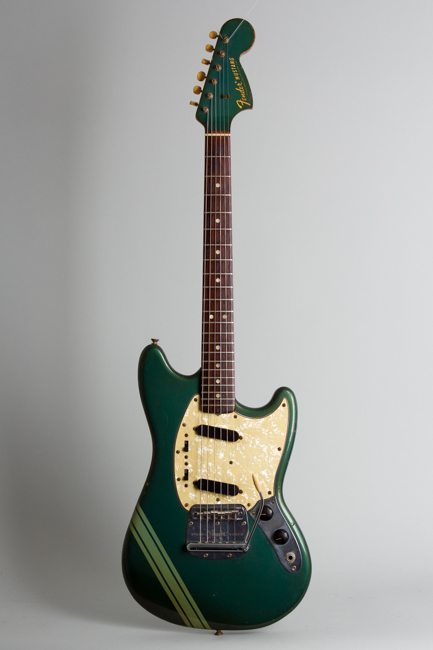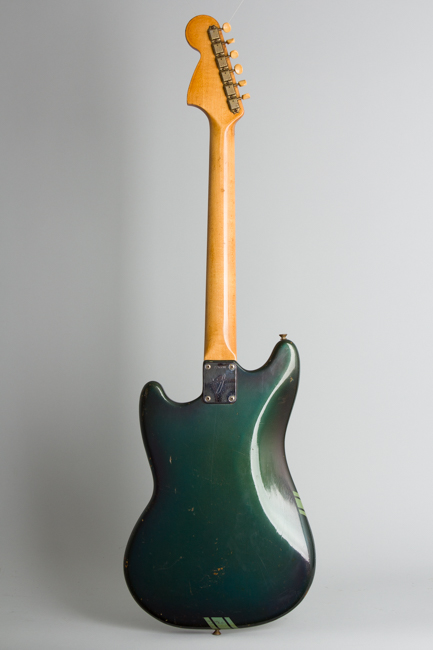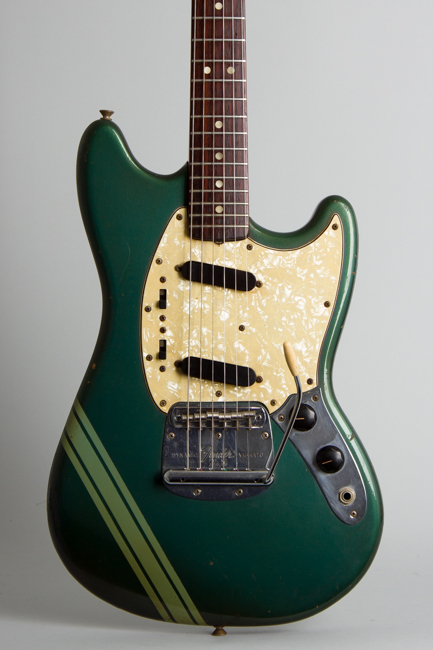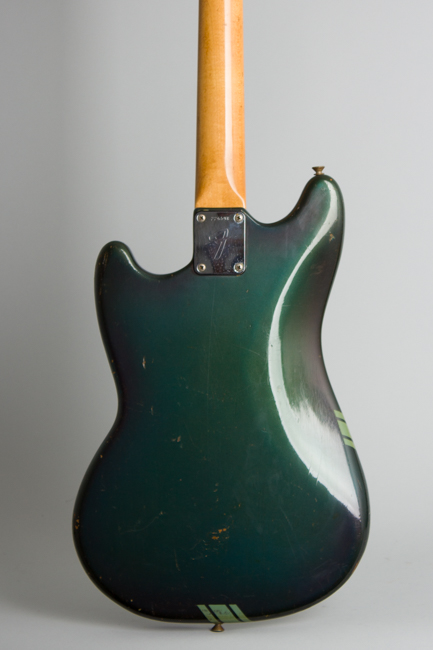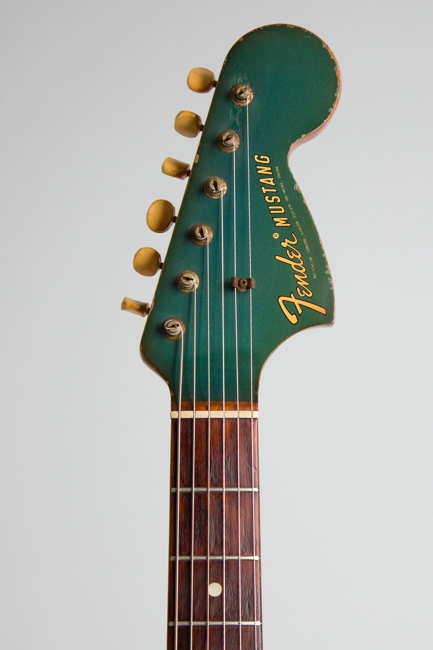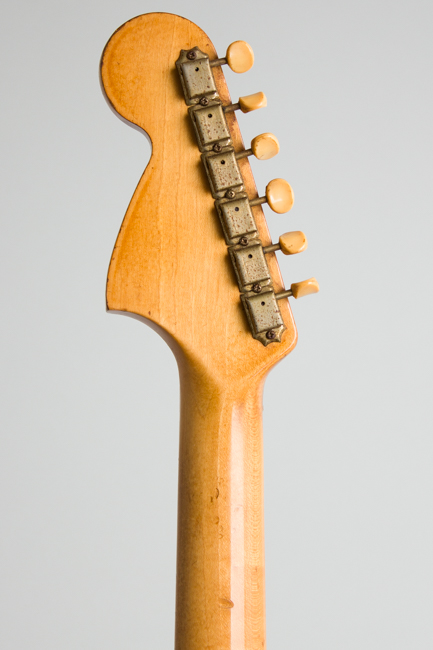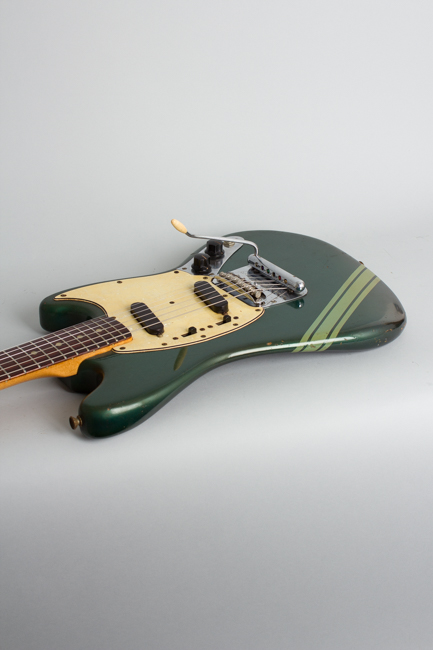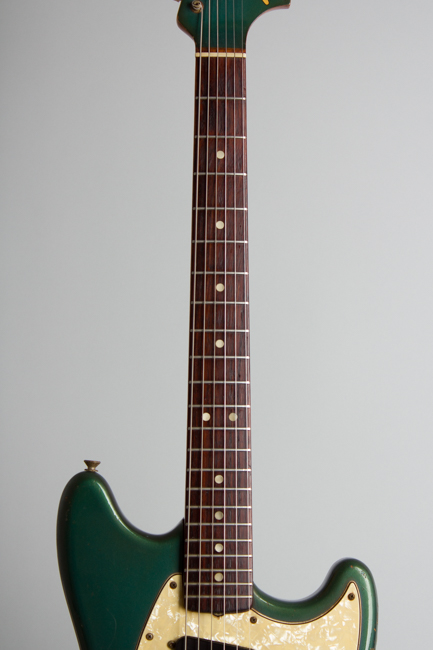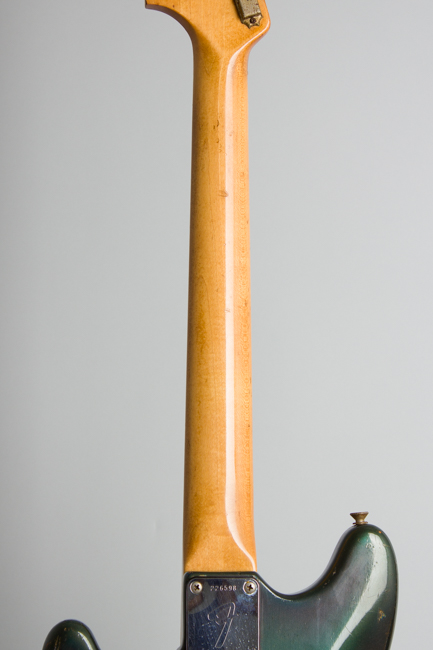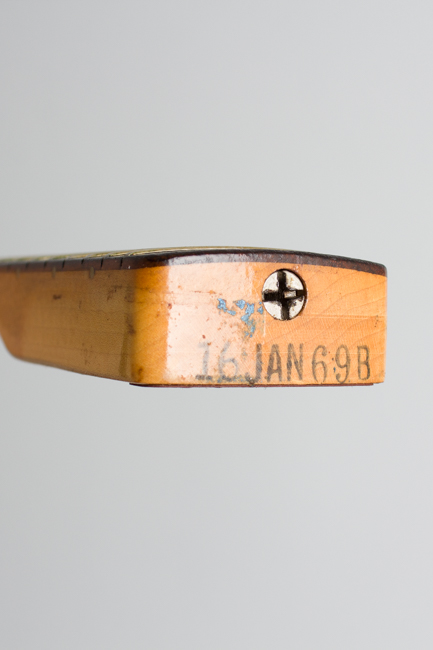Fender Competition Mustang Solid Body Electric Guitar (1969)
This item has been sold.
Item # 10907
Prices subject to change without notice.
Fender Competition Mustang Model Solid Body Electric Guitar (1969), made in Fullerton, California, Lake Placid Blue with Racing Stripe finish, alder body, maple neck with rosewood fingerboard, original grey hard shell case.
This is a very early original example of one of Fender's more Whimsical late 1960s creations, the Competition Blue Mustang. This guitar was built right at the beginning of the run for the "Competition" version of the model. These were introduced in the May 1969 issue of FENDER FACTS to freshen up the model's appeal, incorporating "added features and all new styling". The Blue metallic "car" finish and "racing" stripe on the body (and a snazzy matching headstock) were meant to evoke the car culture "The kids" were thought to be digging at the time. "Competition Mustangs hit the line" was the headline "three diagonal competition stripes race across the body -- big, bold, bright".
This one has a neck stamped JAN 69B and a pot dated to the 31st week of 1966, marking it as one of the very first of the new style. Competition Mustangs were available for a few years from 1969 into the early '70s and while not overly rare are not nearly as plentiful as earlier 1965-66 versions. Only the early first year or so's models were finished out with the matching headstock, making this one an even snazzier find! The body had an added arm cut like a Stratocaster, but otherwise the splashier finish was the main attraction. The finish was described in the Fender promo as "Burgundy with light blue stripe" but is very close to the Lake Placid Blue Metallic already in the Fender spray palette.
Originally introduced in mid-1964, the Mustang series was one of Leo Fender's last major original designs for the company that bore his name. Although intended as a student model, the easy handling short scale guitar with vibrato has been used by many professionals over the decades since and endured as a classic in its own right. The Mustang has proved a timeless favorite of countless garage and pro bands from the 1960s and '70s until today, easily exceeding Leo's original intentions as a simple but effective student instrument.
The FENDER FACTS introductory piece mentions left-handed examples are available "by special order". Decades later one of these early rare southpaw blue models ended up in Kurt Cobain's hands, making this version forever associated with his legend. He called it his favorite guitar, and this early 1969 example is a close a right-handed approximation of that instrument as we have seen in a long time.
Overall length is 39 3/4 in. (101 cm.), 12 1/4 in. (31.1 cm.) wide at lower bout, and 1 5/8 in. (4.1 cm.) in depth, measured at side of rim. Scale length is 24 in. (610 mm.). Width of nut is 1 5/8 in. (41 mm.).
This little blue hot rod appears played but not abused and remains unaltered except for a long-ago replaced volume pot. The finish has faded quite a bit; the dark blue is now a lighter almost turquoise color that we actually find more attractive! The original hue can be clearly seen on the unexposed areas of the body. The finish has a nice lightly aged patina and has some dings, chips and dents overall, notably on the headstock edges. The neck and headstock have a more "smoked" look; this guitar must have spent time in some smoky clubs but has no funky odors lingering. The tuners and bushings have more corrosion than the rest of the hardware, and there is a tiny area that looks like finish patching between the B and E shafts. .
The pickups and electronics are original except as noted the volume pot was neatly replaced long ago. The pearloid pickguard shows less shrinkage than most, and has no crackled or broken corners as many do. The original hardware is relatively clean with some light corrosion and complete except the snap-on bridge cover is long gone; the trem arm remains original. There is some minor fingerboard and fret wear in the lower positions, but not enough to affect playability. The original case is solid showing some general wear; the top latch is broken. Overall this is a very nice example of one of CBS/Fender's cooler late 1960's ideas, and except for not being "upside down" the exact correct "Cobain" version. Overall Excellent - Condition.
This is a very early original example of one of Fender's more Whimsical late 1960s creations, the Competition Blue Mustang. This guitar was built right at the beginning of the run for the "Competition" version of the model. These were introduced in the May 1969 issue of FENDER FACTS to freshen up the model's appeal, incorporating "added features and all new styling". The Blue metallic "car" finish and "racing" stripe on the body (and a snazzy matching headstock) were meant to evoke the car culture "The kids" were thought to be digging at the time. "Competition Mustangs hit the line" was the headline "three diagonal competition stripes race across the body -- big, bold, bright".
This one has a neck stamped JAN 69B and a pot dated to the 31st week of 1966, marking it as one of the very first of the new style. Competition Mustangs were available for a few years from 1969 into the early '70s and while not overly rare are not nearly as plentiful as earlier 1965-66 versions. Only the early first year or so's models were finished out with the matching headstock, making this one an even snazzier find! The body had an added arm cut like a Stratocaster, but otherwise the splashier finish was the main attraction. The finish was described in the Fender promo as "Burgundy with light blue stripe" but is very close to the Lake Placid Blue Metallic already in the Fender spray palette.
Originally introduced in mid-1964, the Mustang series was one of Leo Fender's last major original designs for the company that bore his name. Although intended as a student model, the easy handling short scale guitar with vibrato has been used by many professionals over the decades since and endured as a classic in its own right. The Mustang has proved a timeless favorite of countless garage and pro bands from the 1960s and '70s until today, easily exceeding Leo's original intentions as a simple but effective student instrument.
The FENDER FACTS introductory piece mentions left-handed examples are available "by special order". Decades later one of these early rare southpaw blue models ended up in Kurt Cobain's hands, making this version forever associated with his legend. He called it his favorite guitar, and this early 1969 example is a close a right-handed approximation of that instrument as we have seen in a long time.
Overall length is 39 3/4 in. (101 cm.), 12 1/4 in. (31.1 cm.) wide at lower bout, and 1 5/8 in. (4.1 cm.) in depth, measured at side of rim. Scale length is 24 in. (610 mm.). Width of nut is 1 5/8 in. (41 mm.).
This little blue hot rod appears played but not abused and remains unaltered except for a long-ago replaced volume pot. The finish has faded quite a bit; the dark blue is now a lighter almost turquoise color that we actually find more attractive! The original hue can be clearly seen on the unexposed areas of the body. The finish has a nice lightly aged patina and has some dings, chips and dents overall, notably on the headstock edges. The neck and headstock have a more "smoked" look; this guitar must have spent time in some smoky clubs but has no funky odors lingering. The tuners and bushings have more corrosion than the rest of the hardware, and there is a tiny area that looks like finish patching between the B and E shafts. .
The pickups and electronics are original except as noted the volume pot was neatly replaced long ago. The pearloid pickguard shows less shrinkage than most, and has no crackled or broken corners as many do. The original hardware is relatively clean with some light corrosion and complete except the snap-on bridge cover is long gone; the trem arm remains original. There is some minor fingerboard and fret wear in the lower positions, but not enough to affect playability. The original case is solid showing some general wear; the top latch is broken. Overall this is a very nice example of one of CBS/Fender's cooler late 1960's ideas, and except for not being "upside down" the exact correct "Cobain" version. Overall Excellent - Condition.
